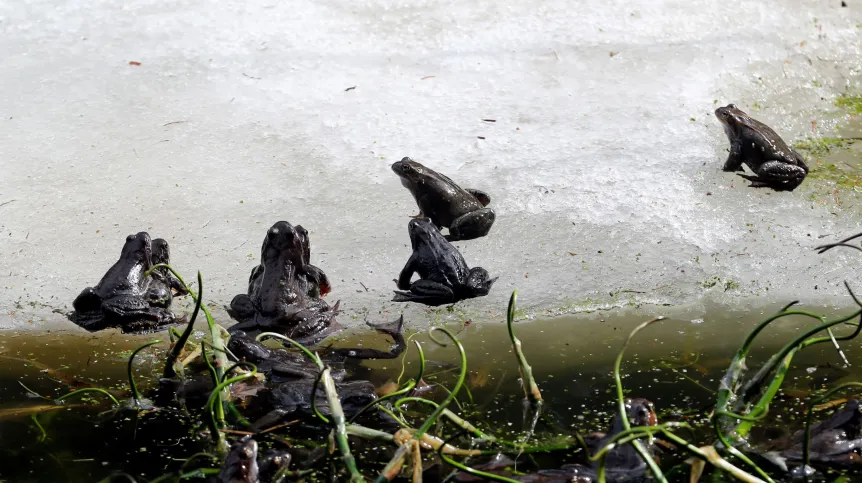
Is it possible to predict potential hotspots of amphibian roadkill? How to use the available data on their amphibians dying under the wheels of cars? What affects the risk of becoming a roadkill? Scientists from Czechia, Spain and Poland investigated the topic and published their results in the Journal of Environmental Management.
Research co-author, Dr. Mikołaj Kaczmarski from the Poznań University of Life Sciences, said that the mortality rate observed among amphibians on the roads is a very big problem that contributes to their global extinction, along with other factors such as climate change, habitat destruction, the destructive impact of invasive species and global disease pathogen epidemic.
'The importance of this problem is growing with the growing number of cars on the roads and the expansion of transport infrastructure. This is a very worrying phenomenon, especially considering the decline of amphibian populations in Europe, including Poland, and on other continents, observed for years,’ he says. The scientist has been dealing with the problem of amphibian mortality on roads in Poland for years. Michał Szkudlarek, a doctoral candidate from the University of Zielona Góra, also participated in the new research.
In the new study, scientists analysed data on the mortality rate of 39 amphibian species. They were obtained on the basis of literature data containing the results of 42 field studies in 11 European countries. Most publications contained data on mortality in Spain and Portugal, followed by Poland.
The researchers wanted to estimate the 'relative roadkill risk' for different groups of amphibians. They analysed a large data set, taking into account the spatial distribution of amphibians in Spain, the total length of roads and their density in a spatial unit. Finally, the researchers developed a map to assess the risk of death on roads for amphibians across Spain, with a spatial resolution of 10x10 km.
'It has been confirmed - for the first time on a European scale - that very numerous species with a wide range of occurrence are usually killed on roads,’ says Dr. Kaczmarski, adding: ’For years, almost all over Europe, the common toad (Bufo bufo) and the spiny toad (Bufo spinosus) have been the most common victims of road traffic. Based on our calculations, we can confirm that fire salamanders (Salamandra salamandra), natterjack toads (Epidalea calamita) and common frogs (Rana temporaria) are also killed en masse in Europe.
'According to our model in the perspective of Spain, the species most vulnerable to mortality are: the painted frog (Discoglossus pictus), the Mediterranean tree frog (Hyla meridionalis), the above-mentioned spiny toad (Bufo spinosus), the Iberian midwife toad (Alytes cisternasii) and two tailed amphibians – the Iberian ribbed newt (Pleurodeles waltl) and the marbled newt (Triturus marmoratus).’
The authors of the study found no link between the frequency of mortality and the evolutionary distinctiveness of individual species or their International Union for Conservation of Nature (IUCN) conservation status.
The method for assessing the amphibian roadkill risk applies to large spatial scales and allows researchers to identify areas that require detailed research on a local scale in order to identify roadkill hotspots. 'It is there that urgent measures need to be taken to minimise amphibian mortality. This approach is particularly important in view of the limited financial resources for nature conservation and the lack of a sufficient number of experts in the field,’ says Dr. Kaczmarski.
'We hope that our research will contribute to more systemic actions to protect amphibians, and the proposed method will be implemented in other countries, especially those outside Europe, with high species diversity,’ he adds.
When analysing the papers on amphibians in Europe published in recent years, scientists have noticed that most studies on their mortality on roads came from the Iberian Peninsula and Central and Eastern Europe. On the other hand, researchers from other regions, such as the UK, Germany and Scandinavian countries, devote more attention to testing solutions to protect amphibians.
According to Kaczmarski, the situation in Western Europe is due to the better development of infrastructure to protect amphibians and the routine use of mitigation solutions, such as local road closures. 'These countries are at a different stage of conservation,’ he says.
What is the situation in Poland when it comes to amphibian conservation planning, related to the planning and construction of new roads? 'Amphibians are a poorly studied group of animals, and the problem of their protection on roads is not viewed on a large scale. A lot of passages for amphibians are built, but their locations are often selected on the basis of poor information. Equipping a given road section with passages often depends to a greater extent on the quality of the inventory, rather than on the actual number of amphibians in a given area and their vulnerability, Kaczmarski tells PAP- Science in Poland.
He adds that during road reconstruction, solutions to protect amphibians are often not taken into account in places where it is known that they are needed. 'Theoretically, there are funds for the protection of amphibians - but they are spent unevenly and not necessarily where the best results can be achieved. And naturalists working in the field know where amphibians are dying,’ he says.
Ordinary citizens can help protect amphibians on the roads by observing run over individuals and reporting such places to the online National Register of Road Collisions with Animals. The information collected there can be used by Regional Directors for Environmental Protection when agreeing on road investments. (PAP)
PAP - Science in Poland
zan/ bar/ kap/
tr. RL













